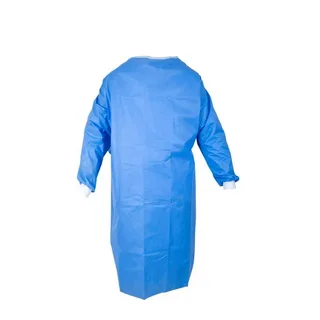In today’s healthcare environment, ensuring the safety of both patients and healthcare professionals is paramount. One essential piece of protective equipment that plays a crucial role in preventing the spread of infections is isolation gowns. These gowns are designed to provide reliable protection in medical settings, offering durability and comfort while keeping healthcare workers safe. If you want to enhance the security level in your healthcare facility, it’s time to order your isolation-gowns now.
The Importance of Isolation-gowns in Healthcare Settings
Isolation-gowns play a pivotal role within healthcare environments, acting as a frontline defense against the transmission of infectious diseases. These protective garments are essential for maintaining stringent infection control protocols and safeguarding patients and healthcare workers from potential cross-contamination. In a setting where the risk of infection can be high and the consequences severe, isolation-gowns underlines the commitment to hygiene and safety standards. Their implementation significantly contributes to an overarching strategy aimed at minimizing infection risks.
In a climate where health threats constantly evolve, adopting such precautions is more critical than ever. These gowns ensure barrier protection integral to routine infection prevention practices, reinforcing the hygiene measures in hospitals, clinics, and other medical facilities. With infectious agents being an omnipresent risk, isolation-gowns provide a necessary shield, emphasizing the importance of protective clothing in the complex dynamics of healthcare safety protocols.
Key Features of Durable and Reliable Isolation-gowns
Selecting the right isolation-gowns involves focusing on features that assure durability and reliability, which are crucial for the rigorous demands of healthcare settings. Optimal isolation-gowns are crafted from materials that effectively block the penetration of liquids, microorganisms, and other potentially infectious materials, ensuring a high level of protection against contamination. These gowns are subjected to rigorous testing to guarantee that they meet the highest barrier protection standards.
Additionally, these gowns must be designed for practical use; features such as adjustable ties or elastic cuffs, water-resistant coatings, and reinforced seams enhance their functionality and wear ability. Incorporating breathable fabrics also contributes to maintaining comfort over prolonged periods, supporting healthcare professionals in their extended duties without sacrificing safety. Gowns that are easy to put on and remove promote adherence to safety protocols, reducing the risk of self-contamination.
By prioritizing these key features, healthcare facilities can provide their staff with isolation-gowns that offer superior protection and durability tailored to the diverse needs of medical environments.
Ensuring Comfort without Compromising Safety
The physical ease of healthcare professionals is paramount within the demanding environments of healthcare settings. Protective attire, such as isolation-gowns, must not only fulfil their primary function of safeguarding against infections but also ensure that those wearing them can carry out their responsibilities without encumbrance. Achieving a balance between safety and comfort is essential; thus, isolation-gowns are crafted from materials that allow the skin to breathe, thereby preventing excessive heat and moisture buildup during long shifts. The design of these gowns incorporates features like ample space for movement and adjustments to accommodate various body types.
This ensures that tasks can be performed with the necessary agility and precision. Comfort-enhancing elements, such as soft elastic cuffs and lightweight fabric, reduce the sensation of wearing heavy or restrictive clothing, making it easier for healthcare workers to focus on their critical duties. Through this thoughtful integration of functional design and material selection, isolation-gowns contribute to a more focused and efficient healthcare environment without compromising essential safety standards.
Different Types of Isolation-gowns and Their Uses
Navigating the diverse range of isolation-gowns on the market can be challenging, yet understanding the distinctions between each type is crucial for making informed choices tailored to the specific needs of a healthcare environment. Among the most commonly encountered variations are disposable, reusable, and surgical gowns, each designed with particular applications and protection levels in mind.
Disposable gowns serve as a practical solution in scenarios where the risk of contamination is lower, offering a cost-effective means of protection that can be easily discarded after a single use. This feature minimizes the risk of cross-contamination between patients and across different areas of a healthcare facility. Conversely, reusable gowns are crafted from more durable materials, capable of withstanding multiple washes and sterilization cycles. They are suited to environments where gown usage is frequent and exposure to infectious materials is higher.
Surgical gowns are a specialized category engineered to provide a superior level of protection. They are predominantly used during operations or invasive procedures where the risk of exposure to infectious fluids and particles is significantly heightened. Each gown type is meticulously designed to meet specific regulatory standards, protecting healthcare workers against contagious agents during their invaluable work.
Compliance with Medical Standards and Regulations
Ensuring that isolation-gowns adhere to the highest medical standards and regulations is fundamental to safeguarding healthcare environments. When procuring these essential items, selecting gowns conforming to recognized industry benchmarks, such as EN 13795 in Europe and AAMI PB70 in the United States, is imperative. These standards delineate the performance requirements and test methods for surgical drapes, gowns, and clean air suits used as medical devices for patients, clinical staff, and equipment. A gown’s compliance with these criteria indicates its capability to provide effective barrier protection against fluids and microbial penetration, thereby significantly reducing the risk of transmission of pathogens in medical settings.
Healthcare facilities must rigorously assess isolation-gown certification and testing documentation to ensure they meet these stringent requirements. This diligent approach not only aligns with regulatory expectations but also fortifies the trust in protective measures adopted by healthcare providers. By prioritizing certified gowns to meet or exceed these comprehensive standards, healthcare facilities underscore their commitment to the highest level of patient care and staff safety. This commitment is crucial in fostering an environment where health and safety regulations are respected and adhered to, ensuring that every measure is taken to protect against infection risks.
Factors to Consider When Ordering Isolation gowns
When embarking on the procurement of isolation gowns, discernment in selection is critical to ensuring that the needs of your healthcare facility are met with precision. Assessing the specific level of protection required is paramount and hinges on the typical risks encountered in your environment. The nature of procedures conducted and potential exposure to infectious agents will guide this determination. Moreover, choosing between disposable and reusable gowns must consider operational efficiency and environmental impact. The material composition and design of the gown are also crucial factors, as they directly influence both barrier efficacy and wearer comfort.
Selection of the appropriate size and fit must be considered, as ill-fitting gowns can compromise protective capabilities and hinder the performance of healthcare tasks. Deliberate evaluation of these aspects will enable the procurement of isolation-gowns that not only meet but exceed the protective needs of your healthcare setting, ensuring the safety and well-being of staff and patients.
How to Properly Use and Dispose of Isolation-gown?
The correct usage and disposal of isolation-gowns are critical steps in maintaining stringent infection control protocols within healthcare settings. To ensure that these protective garments serve their purpose effectively, healthcare professionals must be trained in the proper techniques for donning and doffing gowns. Initially, one must perform hand hygiene before putting on the gown, securing all ties and ensuring the torso and clothing coverage. The gown should be changed immediately if it becomes soiled and always between patients to mitigate the risk of cross-contamination.
Disposal procedures for isolation-gowns vary depending on whether they are reusable or disposable. Disposable gowns should be removed carefully to avoid dispersing contaminants into the air and immediately placed in a designated waste disposal container, preferably without touching the outside of the gown. Thorough hand hygiene practices follow this. Conversely, reusable gowns require removal without contaminating oneself, followed by placement in a specified receptacle for laundering according to healthcare facility guidelines, ensuring they are cleaned and disinfected before next use.
Adhering to these guidelines contributes to the safety of healthcare environments and supports the sustainability of resources by appropriately managing the lifecycle of isolation-gowns.
Testimonials and Case Studies from Healthcare Professionals
The impact of isolation-gowns in enhancing safety and infection control measures is vividly illustrated through the experiences of those on the frontline. Case studies and healthcare workers’ feedback underscore these protective garments’ tangible benefits. For instance, a nurse from a busy urban hospital shared how introducing high-quality isolation-gowns significantly reduced the incidence of cross-infection within their ward, providing a safer environment for patients and staff. Another example comes from a healthcare assistant in a care home, who noted the ease and efficiency with which the gowns could be donned and doffed, reducing potential contamination and streamlining the care process.
A surgeon also highlighted the confidence that comes from wearing a gown that meets rigorous protection standards during procedures, allowing for greater focus on patient care. These accounts, among many others, reinforce isolation-gowns’ critical role in safeguarding health professionals, underpinning the importance of selecting and utilizing these garments effectively. Through their lens, the value of isolation-gowns extends beyond mere compliance with safety protocols, shaping a culture of conscientious care and resilience against infection risks.
Conclusion
The indispensable role of isolation gowns within healthcare environments cannot be overstated. These garments are pivotal in the efforts to maintain a sterile atmosphere, crucial for the well-being of patients and the workforce alike. Making an investment in quality isolation-gowns is not merely a regulatory requirement but a profound commitment to public health and safety. The selection and proper utilization of these gowns are fundamental actions that reflect an organization’s dedication to fostering a secure and productive healthcare setting. As the healthcare landscape continues to evolve, the significance of adopting and implementing advanced protective measures, such as the use of isolation-gowns, becomes increasingly apparent.
FAQs
What are isolation gowns used for?
Isolation gowns are worn by healthcare professionals to protect themselves and their patients from the spread of infections, particularly in settings where there is a high risk of contamination through contact with bodily fluids or infectious agents.
How often should isolation-gowns be changed?
It is essential to change isolation-gowns between treating different patients or immediately after the gown has been soiled to prevent cross-contamination.
Can isolation-gowns be washed and reused?
Some isolation-gowns are designed to be disposable, whilst others are reusable and can withstand multiple washes. The choice depends on the specific needs of the healthcare facility and the level of exposure risk.
How do I dispose of a disposable isolation-gown?
Disposable isolation-gowns should be carefully removed to avoid contaminating the environment and immediately placed in a designated waste disposal container for infectious materials, followed by proper hand hygiene practices.
Are there different types of isolation-gowns?
Yes, there are various types of isolation-gowns, including disposable, reusable, and surgical gowns, each designed for specific situations and levels of exposure risk in healthcare settings.
| Related Business Listings |
| Contact Directory |
| Local Business Profiles |




